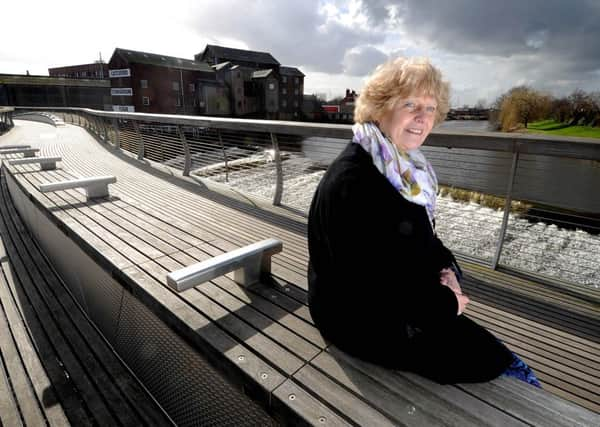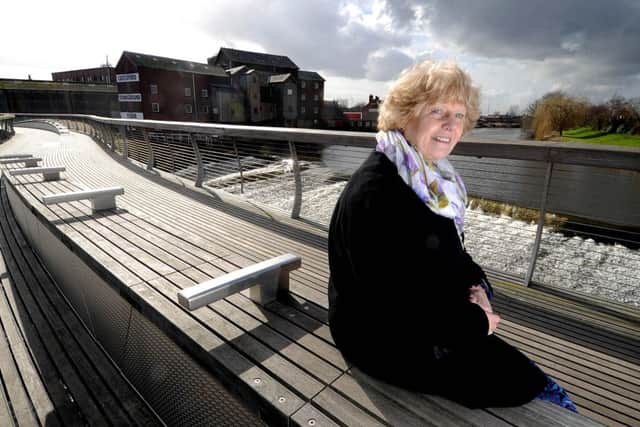Stepping out of the shadows of the coalfields


Alison Drake is standing on the bridge over the River Aire designed by the Canadian architect Renato Benedetti.
For the head of the Castleford Heritage Trust, the £4.8m structure was always meant to be more than just a link between two sides of the former mining town. Part of a wider regeneration programme, which saw century old slag heaps landscaped into a country park and Antony Gormley statues pop up next to a new children’s play area, it was supposed to be a bridge to a brighter future.
Advertisement
Hide AdAdvertisement
Hide AdThe transformation of Castleford was filmed for a Channel 4 documentary and when Grand Designs presenter Kevin McCloud came to the official opening of the bridge in the summer of 2008, the weather reflected the mood of the people. The sun was shining and it finally seemed that there could be life after the bitter Miners Strike and the subsequent pit closures which left thousands in this part of Yorkshire without both work and hope.


Today on a cold, slightly grey March morning the bridge still lends an air of promise to the town, but dark clouds may be once again gathering on the horizon. Ever since Clean Power Properties and Network Rail Infrastructure submitted plans for what they’re calling an energy recovery centre on land close to the town centre there’s been rumblings of discontent.
Alison isn’t buying the promotional blurb or the sleek artist impression. She and many like her say it’s an incinerator and believe if it got given the go ahead it would be the beginning of the end for Castleford.
“I couldn’t believe it when I heard. I felt totally wretched. It goes against everything we have worked for. We’ve taken a lot of knocks in Castleford but I’m not sure we would recover from this.”
Advertisement
Hide AdAdvertisement
Hide AdThe plant would burn up to 195,000 tonnes of industrial and residential waste per year and be in operation 24 hours a day. According to the various campaign groups there are major issues around congestion and it’s long-term environmental impact. More than that, they say it goes against the long-term vision for the town.
Crucial to that plan is the transformation of the former Allinson’s flour mill. The trust bought the building thanks to an anonymous benefactor and as well as getting the stones grinding and the waterwheel turning again, they also want to continue the legacy of the town’s most famous son - Henry Moore.
They’re a little protective of the sculptor in this corner of West Yorkshire. While Leeds, where he trained, has long been home to an institute dedicated to the artist’s work, locals point out that Moore continued to live in Castleford throughout his studies and the town deserves an artistic hub of its own.
As part of the Queens Mill project, a significant chunk of the site is to be given over to a sculpture and art gallery, a centre teaching heritage skills as well as studio and cafe space.
Advertisement
Hide AdAdvertisement
Hide Ad“We are going to have glass windows on both sides of the building which would mean that from the road you could see straight through to the river behind,” says Alison. “It would be really something for Castleford to be proud of.”
Pride was the one thing that kept these close knit communities going even in the darkest days of the 1984-5 strike, but they have taken a knocking over the years. In the 1970s, the area’s eight collieries boasted a workforce of 6,000. By 1997, the figure had fallen to just 600.
Alison was born and bred in Castleford, went to the local grammar school and left in 1980 to pursue a career in teaching. When she came back a four years later, it was already a few months into the Miners Strike and the town was fighting for its survival.
“I was devastated by what I found. I’d left behind a thriving mining community,” she says. “My eldest brother was a mining engineer and he knew everything there was to know about the pits. I’ll always remember him telling me that the industry had a long and prosperous future. There was hundreds of years of coal beneath the ground, but that didn’t seem to matter. The Government had its own agenda.
Advertisement
Hide AdAdvertisement
Hide Ad“I remember teaching children whose parents couldn’t afford to give them breakfast. It was a grim time, but a real fighting spirit emerged and the way the women in particular helped to sustain the community during the strike was typical of Castleford.”
It’s not just the coal industry which has Castleford lost. Once all along the banks of the river were potteries, brick works and glassmakers, but for all its skills the town’s industry couldn’t compete with cheap foreign imports. One by one the factories closed and when the pits went the same way, for a while the town lost its voice.
“For years there was nothing,” says Alison. “We were forgotten and it felt like we were being punished. They didn’t just take the old jobs away, but they didn’t give us anything to replace them.”
The tide began to turn around the Millennium. The dawn of a new century seemed an appropriate time to draw a line under what had gone before. A collaboration between Wakefield Council, English Partnerships and what was Yorkshire Forward got the regeneration ball rolling. However, it was the people of Castleford who drove the project forward, the early plans sparking a real appetite for change.
Advertisement
Hide AdAdvertisement
Hide Ad“It did take us a while to reinvent ourselves,” says Councillor Peter Box, leader of Wakefield Council, who grew up in the town. “You have to remember that there was a time when 58 per cent of men here worked in the pits or in mining related industries. It was the heart of the town and we had to find a new purpose. One good thing that did come out of the strike was the founding of the Castleford Women’s Centre. It helped to give some people round here a purpose, they became community leaders. They have been a vital part of the area’s regeneration and it’s not over.”
While some feared Burberry would leave the town and move to a cheaper operation overseas, the clothing factory has stayed. With the sweet manufacturer, Haribo, announcing at the end of last year it is to open a new factory, there have been recent signs of econmic recovery. Producing 48,000 tonnes of sweets each year, work on the plant, which will employ 286 people, is expected to be completed by next April.
“We had to protect the economy in Castleford,” says Cllr Box, who can trace his own mining heritage back to the 1740s. Until his dad, George decided to follow in his uncle’s footsteps and become a hairdresser, ever single generation had worked down the pits. “That began with the slightly surreal opening of Xscape in 2003. If you’d have told me 10 years before that Castleford would be centre for skiing and snowboarding, I wouldn’t have believed it, but it has been incredibly successful.
“I think we do now have the stability that we craved when the mines closed and the redevelopment of the old mill would be a landmark moment for the town. We are also seriously looking at uncovering the old Roman bath house. I think a lot of people are unaware about Castleford’s links to the past and that would be one way of attracting visitors.”
Advertisement
Hide AdAdvertisement
Hide AdThe council leader admits that not everything has been rosy in Castleford in the past few years. Just months after the opening of the bridge, the bottom dropped out of the economy. Overnight, across the country, lavishly funded regeneration projects and ambitious developments dried up and the town, which was just beginning to find its feet again, was not immune to the downturn.
The Early Bath pub, just a stone’s throw from the rugby ground, is boarded up. There are a number of empty shops in the town centre and the presence of a food bank in the local church are all unfortunate sign of the times.
It’s why those behind the Queens Mill project believe it’s success is now more relevant than ever.
“If you are going to tempt people to live here then you can’t just build houses,” says Alison. “What we are planning is something that will add value to the town, that will give people a reason to come here. The worry is that if the incinerator is given the go ahead, it will put other people off investing.”
Advertisement
Hide AdAdvertisement
Hide AdSince hearing of the plans, Castleford United, which successfully fought off a similar proposal in 2006, has reformed. The group has passed on more than 1,500 objection letters to the local council alongside a detailed letter of objection highlighting their many and various concerns.
It may wll be that planning permission is refused, but there is a determination in the town. They are not leaving anything to chance.
“The Government talks about Big Society, they talk about communities doing things for themselves, but in the end the interests of big business always come first,” says Alison.
“It would be an absolute blight. Just the fact that it might be built is already making people feel uneasy. If I was a housing developer I wouldn’t be rushing to Castleford in case it goes ahead.
Advertisement
Hide AdAdvertisement
Hide Ad“Millions of pounds have been spent regenerating the area, people feel safe here, because it is safe, but every time we seem to turn a corner there is another obstacle in the way. It is more than just a town, the people who live here have a real emotional attachment to the place. Castleford is special. It’s that love which has buoyed us up before, but I can’t help but think that we shouldn’t have to fight this hard.”